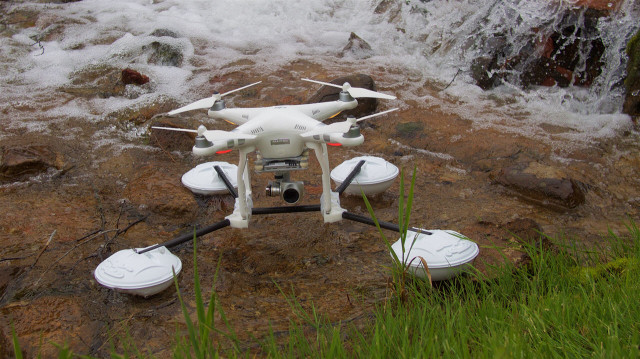 DroneRafts LLC has developed the Patent Pending WaterStrider which bridges the gap between land and water; allowing operators to take their UAV wherever they want to go and liberating them from the concern of where to land.
DroneRafts LLC has developed the Patent Pending WaterStrider which bridges the gap between land and water; allowing operators to take their UAV wherever they want to go and liberating them from the concern of where to land.
WaterStrider is a multi-terrain landing gear system for unmanned aircraft. Designed to fit the DJI Phantom 3 (all variants) and the DJI Phantom 2 (all variants), the WaterStrider easily interfaces with the standard landing gear, enabling the Phantom to takeoff and land from almost anywhere.
“WaterStrider offers existing drone users the ability to dramatically expand their capabilities for completely new uses. We think hobbyists and professionals alike will be able to enjoy and use their drones more in places like pools, lakes, beaches, and even ski slopes.” -David Moser, Co-Founder DroneRafts LLC.
DroneRafts has created a Kickstarter campaign in order to raise funding for manufacturing. With the design complete and test flying done, the group is ready to begin producing WaterStriderTM in quantity. In order to do that, more robust tooling and equipment must be purchased.
“Kickstarter is a natural incubator for drone-related startups and being drone enthusiasts and entrepreneurs ourselves, we are huge supporters for breaking through on Kickstarter. A Kickstarter campaign debut was a perfect fit when considering how to launch the WaterStriderTM.”-Zacheriah Cole, Co-founder DroneRafts LLC
In 2015 David Moser, Zacheriah Cole, and Adam Morrison realized that the drone world would be even better if they could land on water, so they decided to design just such a landing system. The entrepreneurs and mechanical engineers met over a decade earlier at Rose- Hulman Institute of Technology. A shared love of taking things apart and making them better brought them together again to create WaterStrider.
Source: Press Release

While the Idea is not new, plenty of us have put floats on a Quad or Hex before, the real questions are bound to be things like how much efficiency do you loose with that drag and the fact the rotor wash is actually pushing down on the floats, and probably causing stability issues which while the gimbal can correct, it is more work for the gimbal and could lead to issues with the gimbal overheating if it is bad enough.
I like the wide stance, and the distance it keeps the camera away from the water, this should reduce any splashes from the rotor wash from hitting the camera and gimbal. It should be set up to be less than 60 seconds to add or remove.